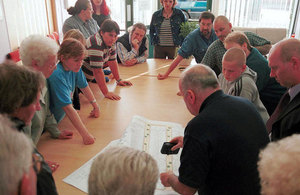£23 million to get more neighbourhood plans across England
New funding to encourage more communities to get involved in neighbourhood planning.

neighbourhood planning
Ministers today (31 October 2014) announced £23 million new funding to encourage more communities across England to get involved in neighbourhood planning, allowing local people to put forward and vote on their proposals for the type of development in their area, and where it should go.
Local people can draw up ‘neighbourhood plans’ that can be used in determining planning applications, and ‘neighbourhood development orders’ that grant planning permission, and vote them into force in a referendum.
Around 1,200 communities across England have already begun the process of neighbourhood planning, with 33 plans and 1 order having been approved in local referendums – a 100% success rate. The coalition government has so far supported more than 700 local groups with developing their plans.
Housing Minister Brandon Lewis said:
With more than a thousand communities across the country already involved in neighbourhood planning this government is giving local people a real say in shaping what gets built where in their local area, and encouraging much needed new house building.
I now want to take this further, to get more people and communities involved in neighbourhood planning, and the £23 million I am announcing today will help many more community groups to bring their neighbourhood plans into reality.
Minister for Communities Stephen Williams said:
This coalition government pledged right from the start to give people back powers to decide for themselves how to run their community and this additional £23 million for neighbourhood planning is another example of how we’re delivering on that.
Whether it’s allowing people to list a treasured local asset against sell off, encouraging share offers to buy the local pub or getting people together to decide what should be built where, this coalition government is shifting power back locally.
Neighbourhood planning – part of the coalition government’s localism agenda to give more power to local people – allows people to choose where new housing and businesses should go, the size and density of new building and can give the green light to developments.
The funding announced today will help more communities become neighbourhood planning areas by:
-
providing community groups a further £1 million for grants during this financial year, in addition to the £4.25 million already awarded since 2013 - grants of up to £7,000 can now be applied for on mycommunityrights.org.uk.
-
making available £22.5 million over 2015 to 2018 to provide community groups with expert advice, grant funding and technical assistance to get neighbourhood plans and orders from their inception to their coming into force following a local referendum - this is a 50% increase in the value of the existing support
-
providing £100,000 to enable groups to organise workshops on neighbourhood planning in their local area, run by knowledgeable advocates of neighbourhood planning and aiming to give communities the information and encouragement needed to start on a neighbourhood plan
Local planning authorities can also take advantage of a £12 million funding pot to help them meet the cost of their responsibilities and to support local communities by claiming up to £100,000 a year each to help their communities start a neighbourhood plan, with an additional £25,000 for each plan or order that passes an examination.
The coalition government is also encouraging communities to consider how neighbourhood planning could help address local issues in the future. A range of support services, including grants, a dedicated phone line, and advice from planning experts are currently available.
New evidence published today also suggests that communities have largely been able to access the skills, knowledge and support they need for neighbourhood planning. This is according to the first primary research of its kind into people’s experiences of neighbourhood planning published today by Locality, conducted by the University of Reading.
View an executive summary of the research or the full report on the mycommunityrights website.
Further informatioin
Local planning authorities can claim £5,000 for each neighbourhood plan area designated, up to a maximum of 20 areas per year. They can also claim a further £5,000 for each ‘neighbourhood forum’ designated.
A further £5,000 can be claimed by the local planning authority when a parish or neighbourhood forum submits a neighbourhood plan (or neighbourhood development order) to them for examination.
The local planning authority can claim a final £20,000 for each successful examination of a neighbourhood plan or order. In business areas an additional £10,000 is available to reflect the need for an additional referendum.
Further information is available on funding for local planning authorities.
Over the coming months the coalition government will be appointing a partner to deliver our new support programme from April 2015.
Locality, the organisation that commissioned the research, is the lead partner in a consortium delivering the coalition government’s neighbourhood planning support programme.
Office address and general enquiries
2 Marsham StreetLondon
SW1P 4DF
Contact form https://www.gov.uk/gui...
General enquiries: please use this number if you are a member of the public 030 3444 0000
If your enquiry is related to COVID-19 please check our guidance page first before you contact us - https://www.gov.uk/guidance/coronavirus-covid-19-guidance-for-local-government.
If you still need to contact us please use the contact form above to get in touch, because of coronavirus (COVID-19). If you send it by post it will not receive a reply within normal timescale.
Media enquiries
Email newsdesk@communities.gov.uk
Please use this number if you are a journalist wishing to speak to Press Office 0303 444 1209